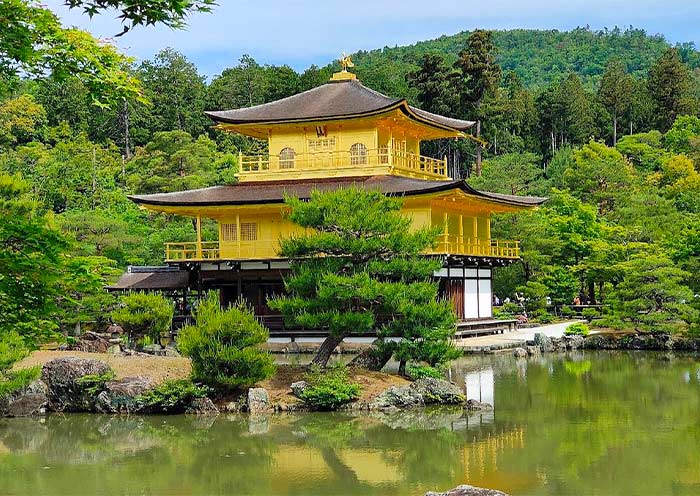Our 8 days group tour in December was amazing! Tokyo’s vibrant streets and Mount Fuji’s snow-capped beauty were breathtaking. Kyoto’s temples and Nara’s deer park offered a serene charm, while Osaka dazzled with its food and nightlife. Hiroshima’s Peace Memorial Park was deeply moving. The crisp winter atmosphere and festive illuminations added a magical touch. Traveling with a small group made the experience fun, seamless, and unforgettable!
16 Days Japan China Tour: Ancient and Modern Faces of East Asia
- Highlights
- Itinerary
- Price
- Trip Notes
- Accommodation
- Photos
- Reviews
Echoes of the Past, Voices of the Present: East Asia in 16 Day
Choosing Japan and China for a first trip to Asia is ideal because these two countries not only represent the cultural depth and diversity of Asia but also share a complex and profound connection.
For instance, Buddhism's introduction to Japan from China in the 6th century profoundly influenced Japanese religion, philosophy, and aesthetics, cultivating Japan's unique Zen traditions and shaping its celebrated arts and garden designs. Modern Japanese pop culture, including anime and fashion, resonates strongly with China's youth.
This 16 Days Japan China Tour features key cities that reflect each country's rich history, culture, and economic development. Travelers can experience the unique heritage and contemporary dynamics of these two neighboring Asian giants. The itinerary is enriched with rides on Japan's Shinkansen and China's high-speed rail, highlighting both countries' advancements in modern transportation.
Japan: Start in Tokyo, the capital of Japan, showcasing the country's modern and high-tech side while preserving many traditional cultural elements. Travel to Mount Fuji, Japan's most iconic natural landmark. Immerse yourself in the ancient capitals of Kyoto and Nara, where ancient temples, colorful shrines, and exquisite Japanese gardens highlight Japan's deep historical and cultural traditions. Conclude your Japanese exploration in Osaka, one of Japan's economic centers, famous for its bustling commercial areas and vibrant culinary scene.
China: Then, fly to Shanghai, one of China's economic powerhouses, where futuristic skyscrapers tower above historic streets. Wander through the classical Chinese gardens of Suzhou, which contrast sharply with Shanghai's modernity. In the ancient capital of Xi'an, stand before the awe-inspiring Terracotta Army and delve into the nightlife of the Tang dynasty's cosmopolitan legacy. The journey culminates in Beijing, China's capital, where you can walk the storied halls of the Forbidden City and traverse the Great Wall, enduring symbols of China's rich past.
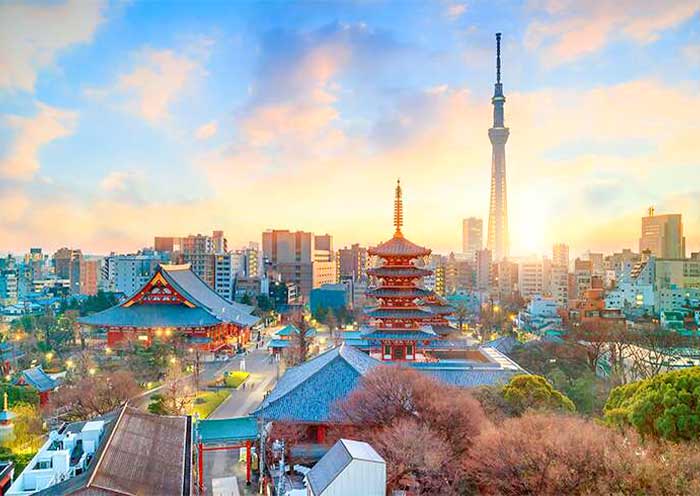


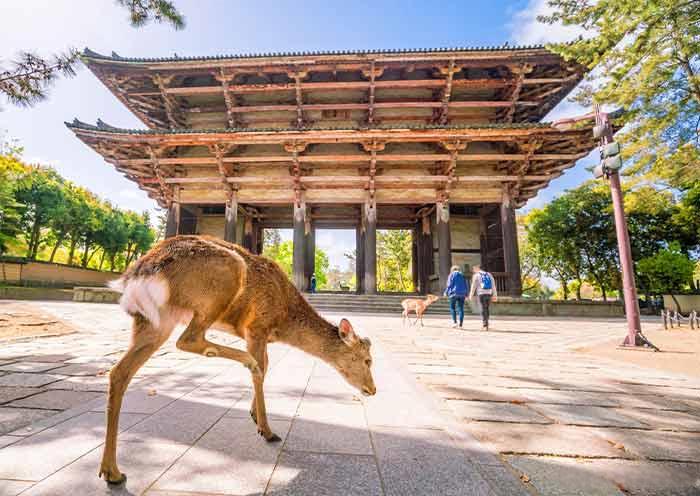

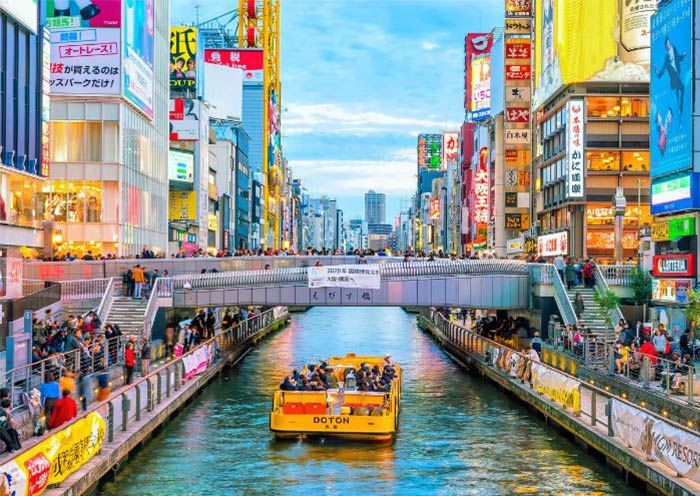


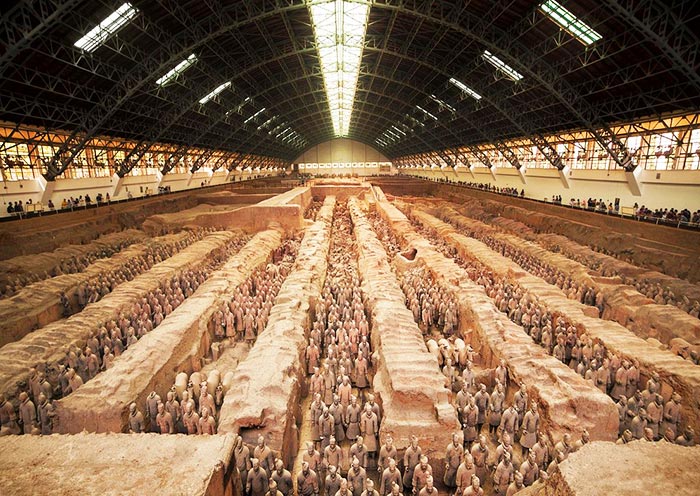

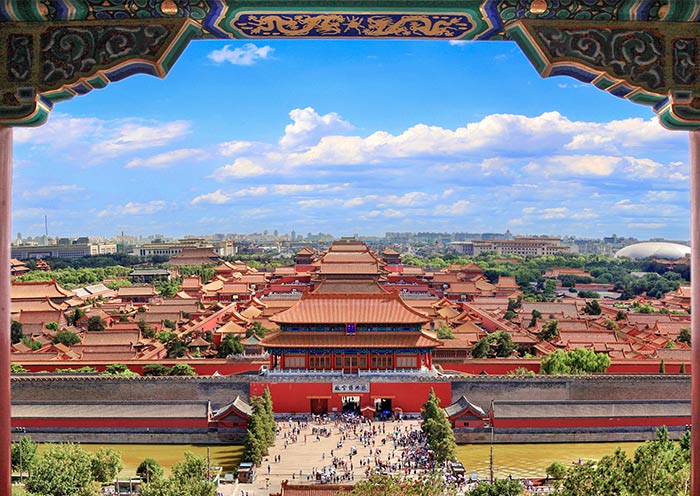
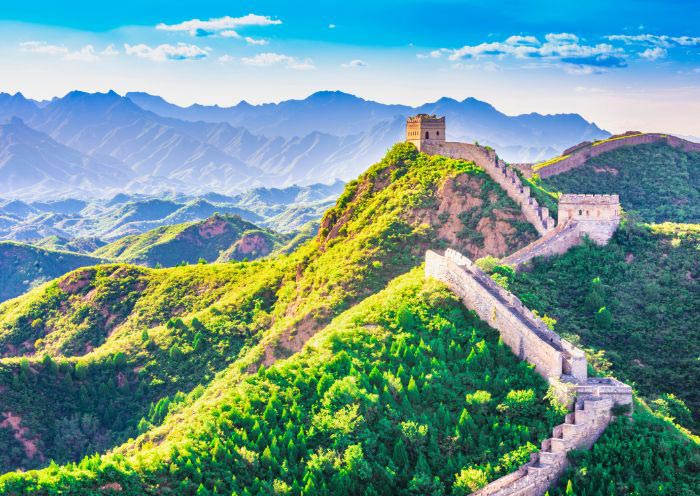
Itinerary at a Glance
Tokyo (2.5 Days)
Meiji Jingu Shrine (Meiji Shrine), Shibuya Crossing, Senso-ji Temple (Asakusa Kannon), Tokyo Skytree (Distant view), Tsukiji Outer Market (Tsukiji Fish Market)
Mt. Fuji (1 Day)
Mount Fuji 5th Station, Arakurayama Sengen Park, Lake Kawaguchi
Kyoto (2.5 Days)
Fushimi Inari Taisha Shrine, Kiyomizudera Temple, Ninenzaka & Sannenzaka, Yasaka Shrine, Gion, Kinkakuji Temple, Sagano Scenic Railway, Arashiyama Bamboo Grove, Tenryuji Temple, Togetsukyo Bridge
Japan Nara (0.5 Day)
Todaiji Temple, Nara Park
Osaka (1.5 Day)
Osaka Castle Park, Dotombori District
Shanghai (2 Days)
Shanghai Tower, Yu Garden, Yuyuan Bazaar, Xintiandi, Nanjing Road, The Bund
Suzhou (1 Day)
Humble Administrator’s Garden, Lion Grove Garden, Tiger Hill, Shantang Street
Xian (2 Day)
Terracotta Warriors & DIY, Giant Wild Goose Pagoda, Hanfu Experience, Grand Tang Dynasty Ever Bright City, Ancient City Wall, Muslim Quarter, Great Mosque, Ancient City Wall, Muslim Quarter, Great Mosque
Beijing (3 Days)
Tian’ anmen Square, Forbidden City, Summer Palace, Mutianyu Great Wall, Bird’s Nest & Water Cube, Temple of Heaven, Old Hutongs
Itinerary Day by Day
Konnichiwa(こんにちは)!Welcome to Tokyo, the capital city of Japan! Upon your arrival at the airport in Tokyo, your driver (not English-speaking) will meet you at the exit and then escort you to the hotel. You can have a good rest in your hotel and get ready to explore Tokyo with your guide the next day.
Tokyo, the capital of Japan, is one of Japan and Asia's largest economic centers. Tokyo is a hub for Japanese culture and art, with numerous museums, art galleries, theaters, and cultural venues, serving as a vital platform for artistic activities and cultural exchanges. Tokyo stands as a significant base for technological advancement, nurturing numerous high-tech companies and innovative talents, holding leading positions globally in areas like electronics, automotive, and robotics technology.
Situated at the southern end of the Kanto Plain, Tokyo is surrounded by diverse natural landscapes including Mount Fuji, providing residents with leisure and outdoor activity spaces. At one point, the population of the Tokyo metropolitan area reached 36 million, accounting for one-third of Japan's total population. Despite the high cost of living, Tokyo provides residents with convenient living conditions, offering a plethora of shopping centers, entertainment facilities, and a rich culinary culture ranging from fine dining to street food.
Arrival Ideas:
- Japan has two commonly used international airports. Narita International Airport, located 63.5 kilometers from the center of Tokyo, is the primary international air hub for Tokyo, where flights from China to Tokyo usually land. Tokyo International Airport (Haneda Airport), is situated 17 kilometers from the center of Tokyo and mainly serves domestic flights within Japan and some international flights, including flights to South Korea and other East Asian regions.
- Cities that have direct flights to Tokyoinclude, but are not limited to: Beijing, Shanghai, Guangzhou, Shenzhen, Hangzhou, Xi'an, Chengdu, Chongqing, Hong Kong, Taipei, Kaohsiung, Seoul, Singapore, Bangkok, Kuala Lumpur, Jakarta, Bali, Manila, Ho Chi Minh City, Hanoi, and more. Please note that flight information is subject to changes based on time and market demand. Contact us to obtain the latest flight information and prices.
- In Japan, using public transportation such as the subway & JR trains is recommended to save costs, avoid traffic congestion, and help reduce carbon emissions. Taxi fares in Japan are relatively high, with a starting fare of around 660 Japanese yen and 140 yen per kilometer. Waiting time is also charged. Surcharges are applicable during nighttime and peak hours (+20%), and expressway tolls are additional. Extra fees are levied for large luggage. For instance, a taxi ride from Tokyo Tower to Narita Airport, covering about 60-70 km, might cost around 25,000-35,000 Japanese yen (roughly 170-237 USD).
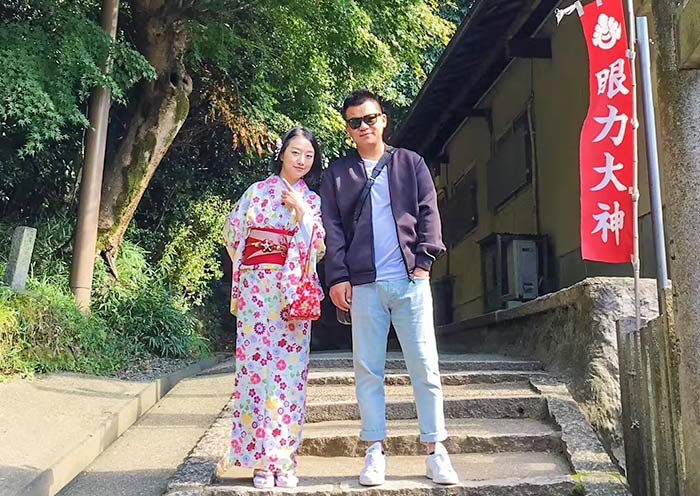

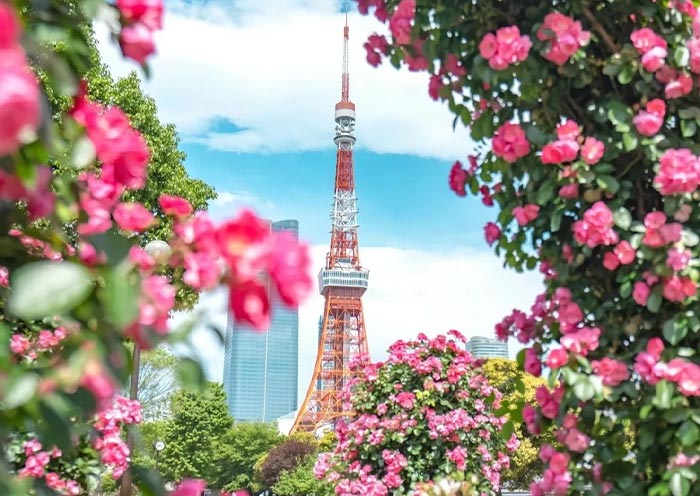

First to visit Meiji Jingu Shrine (Meiji Shrine), a Shinto Shrine dedicated to Emperor Meiji (1852-1912) and Empress Shoken (1849-1914), who played a crucial role in modernizing Japan while excelled in writing Waka (traditional Japanese poems of 31 syllables in the pattern 5-7-5-7-7). Meiji Shrine is also a popular venue for traditional weddings, where you will have the opportunity to witness a Japanese wedding procession and experience the charm of Japanese traditional culture.
The Meiji Shrine is nestled within a tranquil forest that covers an area of 70 hectares, providing a peaceful escape from the bustling city. This forest is home to over 100,000 trees that were donated from regions across Japan during the shrine's construction, in honor of their beloved Emperor Meiji (who established Shinto as the state religion) and Empress Shoken.
Take a stroll along the paths and enjoy the fresh air and natural beauty. You will walk through Japan's largest wooden Torii gate, standing in its natural wooden hue and weighing up to 13 tons. The Torii gate serves as the Symbol of Shinto Shrines, marking the transition from the worldly to the sacred. Then, you will notice the impressive Sake Barrel Wall along the South Approach, which features offerings from sake breweries and believers across Japan, including barrels of sake and Western liquor, reflecting Emperor Meiji's fondness for Western culture.
At the main hall of Meiji Shrine, you can witness locals washing their hands and rinsing their mouths at Purification Font before worship as a sign of respect. You can offer a 5-yen coin (symbolizing a connection) like locals and pray for blessings. In the eyes of the Japanese, Meiji Shrine is considered to have such boundless capabilities, from naming ceremonies for newborns, to coming-of-age ceremonies, graduation ceremonies, seeking marriage partners, praying for world peace, family well-being, safe travels, good health, warding off calamity, etc.
In addition to immersing yourself in Japanese Shinto traditions and architecture, revel in the enchanting surroundings filled with lush trees, serene ponds, graceful bridges, and stone pathways that epitomize the essence of traditional Japanese garden art. You should visit here to enjoy the vibrant bloom of cherry blossoms in spring, the verdant beauty of summer, the fiery hues of autumn leaves, and the serene snowy landscapes of winter.
Tips for Visiting Meiji Jingu Shrine:
- Wear modest clothing: Respect the sacred nature of the shrine by dressing appropriately.
- Be mindful of noise levels: Maintain a quiet and respectful atmosphere.
- Inner Garden (Optional; self-pay; once Imperial Property), and Meiji Jingu Museum (Optional; self-pay; items used by the imperial couple).
Then, move to visit Shibuya Crossing, one of the busiest intersections in the world, accommodating approximately 3,000 people per minute. As one of Tokyo's iconic locations, Shibuya attracts tourists and photographers from around the globe who come to observe and capture its essence. Numerous movies, TV shows, commercials, and music videos are filmed at this location, such as "The Fast and the Furious: Tokyo Drift."
Additionally, if you're interested in the story of Hachiko, the loyal dog, you can also visit his bronze statue. This Hachiko statue is located outside Shibuya Station and was erected to commemorate Hachiko's loyalty. Not only is it a popular meeting spot, but it's also a must-visit attraction for tourists. The statue symbolizes the power of loyalty and love, serving as a touching tribute.
In the afternoon, head to Senso-ji Temple (Asakusa Kannon Temple), a must-visit for anyone traveling to Tokyo. While there, be sure to capture a photo of Tokyo Skytree, Japan's tallest tower, visible in the distance.
Senso-ji Temple (Asakusa Kannon Temple), is one of the oldest and most famous Buddhist temples in Tokyo, located in the Asakusa district of Taito, Tokyo. The temple is dedicated to Kannon Bosatsu (Avalokiteshvara), the Bodhisattva of compassion. According to legend, in 628 AD, two fishermen retrieved a statue of Kannon from the Sumida River and decided to construct a temple to enshrine it. Completed in 645 AD, Senso-ji has since become a spiritual symbol of Tokyo.
The temple's entrance is marked by the iconic Kaminarimon (Thunder Gate), featuring a massive red lantern and protective deity statues that symbolize the temple's guardians against evil spirits. This gate is a popular photo spot and marks the beginning of Nakamise Street, a lively shopping street lined with stalls offering traditional Japanese snacks, crafts, and souvenirs, which leads up to the temple's second gate, the Hozomon.
Beyond the Hozomon lies the main hall, dedicated to Kannon and adorned with exquisite decorations, where devotees pray and worship. Adjacent to the main hall is the temple’s five-story pagoda, another striking feature, representing the traditional Japanese architectural style and symbolizing the five elements of Buddhist cosmology - earth, water, fire, wind, and void.
From Senso-ji looking south, you capture a photograph of Skytree Tower (Japan's Tallest Tower; 634 meters). On this street, you can see both old buildings and modern skyscrapers together, providing a visual contrast between traditional and modern.
After that, you can explore Tsukiji Fish Market (Now Toyosu Market). Tsukiji Fish Market was once the world's largest fish market, famous for its tuna auctions. However, in 2018, it relocated to a new, larger facility called Toyosu Market. You can still enjoy fresh seafood (sashimi, sushi, or seafood rice bowls), purchase kitchenware, and learn about a variety of seafood, including the characteristics, cooking methods, and nutritional value of different types of seafood.
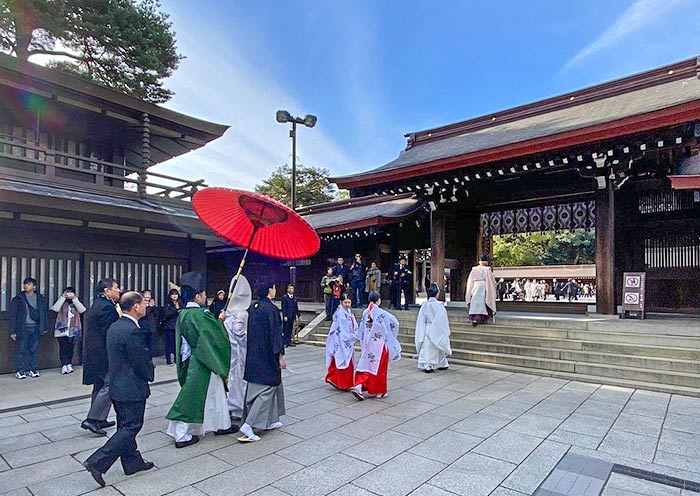


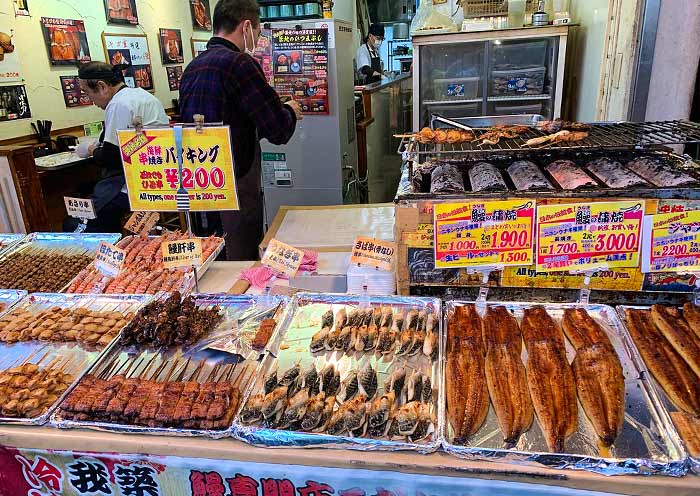
Today, enjoy a full-day trip to admire breathtaking views of Mount Fuji from three vantage points: Mount Fuji 5th Station, Arakurayama Sengen Park, and Lake Kawaguchi. Afterwards, drive back to Tokyo for accommodation.
Mount Fuji is the tallest mountain in Japan. It's a famous volcano with a perfectly symmetrical cone shape. Visiting Mount Fuji is essential for any traveler in Japan. As a UNESCO World Heritage Site, Mount Fuji (3,776m) stands as an iconic symbol of Japan, a cultural and spiritual landmark (recognized as a holy mountain in Shintoism), and a natural marvel. When picturing Mount Fuji, its distinctive perfect cone shape and snow-capped peak likely come to mind. Among the most renowned depictions is Katsushika Hokusai's 'Thirty-Six Views of Mount Fuji'. Hokusai, one of the "Three Greats of Ukiyo-e", is best known for his masterpiece "The Great Wave off Kanagawa" which can be seen on the 1,000 Japanese yen bill.
Start your journey to Mount Fuji 5th Station within the Fuji-Hakone-Izu National Park for a close-up Mount Fuji view. It offers breathtaking panoramic views of Mount Fuji (if weather permits) and the surrounding area, including the Fuji Five Lakes. For those adventurous enough, the 5th Station is the starting point for climbing Mount Fuji. Experience the unique alpine environment and the thrill of being so close to Japan's iconic mountain.
Continue your journey at the renowned Arakurayama Sengen Park, where you can admire the magnificent view of a five-story pagoda set against a backdrop of majestic mountains. Hike about 15-20 minutes up to Arakurayama Sengen Shrine, dedicated to the mountain god. The shrine is surrounded by beautiful gardens and offers a peaceful atmosphere. Enjoy the gorgeous scenery and capture iconic photos at the famous Red Fuji Observation Deck.
Then, head to Lake Kawaguchi for a leisurely walk along the lakeside. Lake Kawaguchi is renowned for its clear waters that often reflect the majestic Mount Fuji (if weather permits), creating a postcard-perfect scene and making it a popular destination for both domestic and international tourists. Additionally, explore the nearby parks, galleries, and museums based on your interests.
Notes:
- It is a long day trip, and there will be a surcharge if the tour exceeds 8 hours (For Guide, driver & vehicle).2. If the weather is clear, you can enjoy a good view of Mt. Fuji. However, if the weather is not favorable, Mt. Fuji may not be visible.
- The best time to view Mount Fuji is generally from December to February when skies are clearer and the peak is snow-capped. And also, April to May (for blooming cherry blossoms) and October to November (for the autumn foliage) are good time。
- Early mornings often provide the best visibility before clouds obscure the view. Different locations around Mount Fuji offer varying perspectives, with some spots known for their clear views.

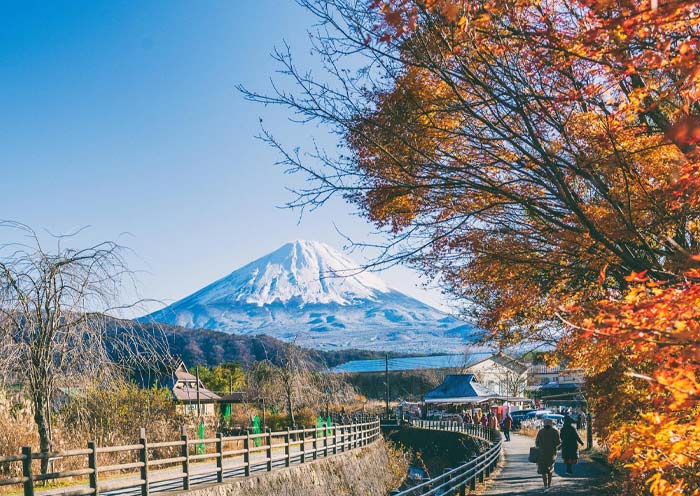

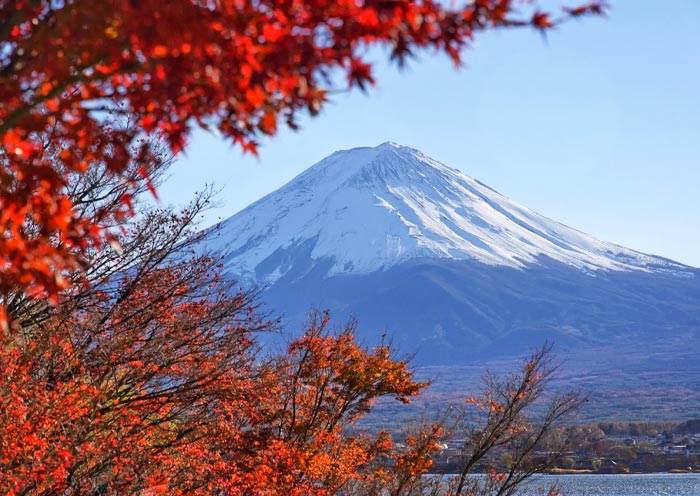
Today, you will take the Shinkansen (bullet train) to Kyoto. A driver will wait for you at the hotel entrance at the scheduled time and transport you to Tokyo Station.
Shinkansen Ride: At Tokyo Station, board the Shinkansen (bullet train) bound for Kyoto Station (about 2.5 hours). This fast and comfortable journey offers a chance to enjoy the changing landscapes of urban and rural Japan.
Upon arrival in Kyoto, a driver holding a sign will wait in the designated area to greet you and provide a private transfer to your hotel. Check into your hotel and take some time to settle in and rest.
Kyoto, located in the Kansai region of the country, was once the capital of Japan. It epitomizes ancient Japan and is famous for tranquil temples, exquisite gardens, colorful shrines, grand imperial palaces, and ornate castles. Boasting 17 UNESCO World Heritage sites, over 1,000 Buddhist temples, and more than 400 Shinto shrines, Kyoto is among the world's most culturally rich cities. It's also known for traditional Japanese arts and practices, such as tea ceremonies, kaiseki dining (a traditional multi-course meal), and ikebana (flower arranging). It remains one of the best places to see geishas, who are traditional Japanese female entertainers known for their refined skills in arts, music, dance, and conversation.
Free Time Ideas in Kyoto:
- Evening Stroll Along the Kamo River:This river flows through the city and provides walking paths with beautiful views. Many cafes and restaurants along the river have terraces, perfect for a relaxing end to your day.
- Walk the Philosopher's Path:Enjoy a peaceful walk along the Philosopher’s Path, a stone path lined with cherry trees that follows a canal in northeastern Kyoto. This path is especially beautiful during cherry blossom season but offers a serene experience year-round.
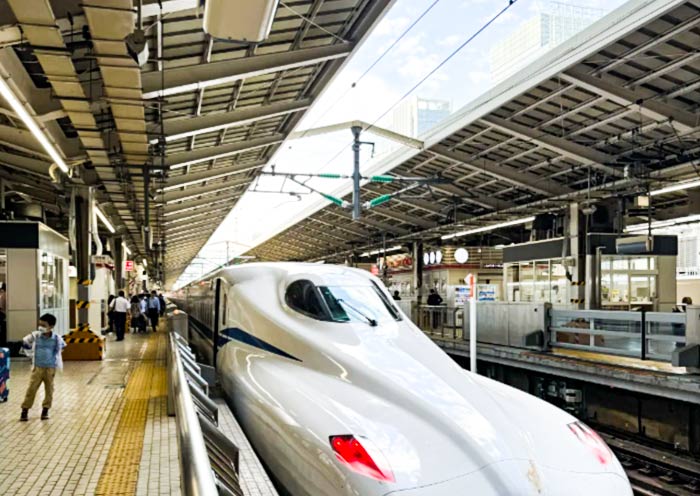

Kyoto, once the capital of Japan, epitomizes ancient Japan. Boasting 17 UNESCO World Heritage sites, over 1,000 Buddhist temples, and more than 400 Shinto shrines, Kyoto is among the world's most culturally rich cities. Known for traditional arts like tea ceremonies, kaiseki dining, and ikebana (flower arranging), Kyoto is also one of the best places to observe geishas.
Start morning in Kyoto bright and early at one of its most iconic sites - the Fushimi Inari Taisha Shrine to beat the crowds.
Fushimi Inari Taisha Shrine is famous for its thousands of vermilion torii gates, known as Senbon Torii (“thousands of torii gates”). Layers upon layers of vermilion torii gates line the lush, wooded hillside, forming a seemingly endless corridor. The vibrant orange and black gates contrast beautifully with the surrounding greenery, creating a visually stunning and almost otherworldly path that is highly photogenic.
Fushimi Inari Taisha was founded in the early 8th century (711 AD) and is primarily dedicated to Inari, the Shinto god of rice, fertility, sake, agriculture, and industry. As you explore the shrine, you will encounter hundreds of fox statues. Said to be the messengers of the god Inari, who is associated with cereal grains, these fox statues often symbolize the deity. Many of these fox statues are depicted holding a key in their mouths, which is said to open the granary.
Tips: Hiking to the summit of the mountain and back will take two to three hours, but many people go only as far as the Yotsutsuji intersection because there are fewer torii gates beyond this point. It will take 30 to 40 minutes to reach Yotsutsuji.
Next, visit Kiyomizudera Temple, a UNESCO World Heritage Site. Perched on the hillside of Eastern Kyoto, this temple is renowned for its wooden stage that juts out over the hill, providing stunning views of the city and the surrounding nature. The temple's main hall, constructed entirely without the use of nails, is an architectural marvel. Kiyomizu-dera is also celebrated for its sacred waters, which are believed to have wish-granting powers that draw countless visitors who come to drink from its stream. Don’t miss the Hondo (Main Hall), Jishu Shrine, the Otowa Waterfall, and the spiritual experience of the Tainai-Meguri room.
Tips: The scenery at Kiyomizu-dera Temple is distinctively beautiful in each season, offering a unique charm year-round. In spring, the mountains are adorned with charming cherry blossoms; in summer, they are lush with vibrant greenery; in autumn, they are decorated with brilliantly colored leaves; and in winter, they are filled with enchanting trees.
Then, walk up the well-preserved streets of Ninenzaka and Sannenzaka. These charming, sloping streets are lined with traditional shops and quaint tea houses, offering a nostalgic glimpse into Kyoto's past. As you stroll through these areas, you can shop for unique crafts, sample local snacks, and perhaps stop at a café to relax and soak in the atmosphere of old Kyoto.
Continue to Yasaka Shrine, the guardian shrine of the Gion entertainment district, which dates back over 1350 years. Yasaka Shrine is particularly favored by those seeking beauty and wealth. Visiting this significant Shinto shrine in Kyoto, you may also find yourself gaining some good luck. The shrine is most famous for its Gion Matsuri in July, during which you can witness the procession where the deities of Yasaka are paraded through the city streets.
Adjacent to the shrine, Gion is Kyoto's famous geisha district. Here, you might catch a glimpse of Geisha (Geiko) in their elaborate kimonos and traditional makeup. As you wander through the cobblestone streets of Gion, take a moment to appreciate the beautifully preserved machiya (wooden townhouses), ochaya (teahouses), and exclusive ryotei (traditional Japanese restaurants). Gion is particularly enchanting at dusk when the lanterns are lit and geishas and maiko (apprentice geishas) make their way to evening appointments, making the narrow lanes come alive.
Stay overnight in Kyoto.
Optional Activities:
- Join a Geisha Experience.It offers a chance to see a performance by a geisha, experience the tea ceremony, and learn all about its artful rituals.
- Kyoto traditional kimono experience.Wear a traditional kimono and stroll through scenic districts like Gion or around Kiyomizu-Dera Temple. Enjoy photo opportunities and the feel of traditional Japan.



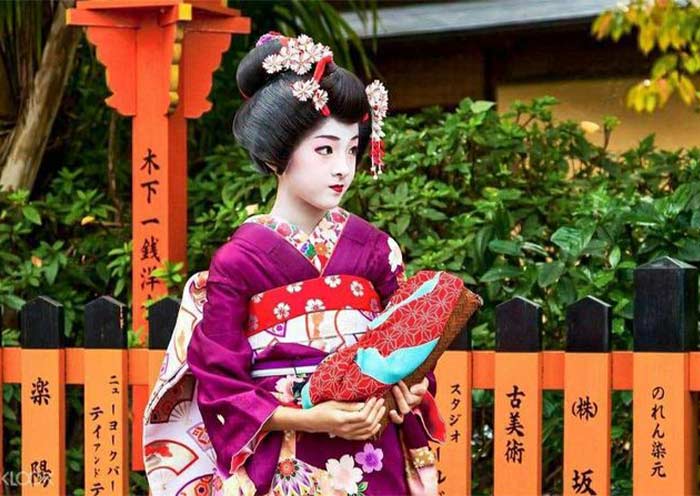
Today, you'll be visiting some of Kyoto's most iconic spots, then head to the Arashiyama and Sagano areas located in the northwest of Kyoto. This itinerary will not only allow you to deeply experience Kyoto's culture and history but also bring you closer to nature, letting you feel the changes of the seasons.
Start your day with a visit to one of Kyoto's most iconic sights, Kinkakuji Temple (Golden Pavilion) - a UNESCO World Heritage site. This Zen Buddhist temple is famous for its stunning golden exterior. The temple's stunning visual appeal comes from its top two floors, which are completely covered in gold leaf. The reflection of the golden structure shimmering in the pond in front of it, makes it perfect for photos and quiet reflection. It was originally built in 1397 as a retirement villa for Shogun Ashikaga Yoshimitsu. After Yoshimitsu's death, as per his will, the villa was converted into a Zen temple by his son.
Head to the Arashiyama area in the western part of Kyoto and take a ride on the Sagano Scenic Railway, also known as the “Romantic Train”. It is a sightseeing train line that runs between Arashiyama and Kameoka.On the way, the train runs along the Hozugawa River gorge, offering fantastic views of the forests and mountains. It is particularly scenic during the autumn foliage season, but in the spring passengers can enjoy the cherry blossoms, in the summer a cool breeze and the sound of cicadas, and in the winter dramatic snowy landscapes.
Exit at Arashiyama Station and walk to the nearby Arashiyama Bamboo Grove. The famous pathway is surrounded by towering bamboo, which creates an otherworldly atmosphere. This path leads you through one of Kyoto's most photographed landscapes.
After a short walk, explore Tenryuji Temple which is designated as a UNESCO World Heritage Site and is one of the so-called Kyoto Gozan or "five great Zen temples of Kyoto". Don't miss the garden, designed by the famous Zen master Muso Soseki, which reflects the concept of shakkei ("borrowed landscape"). Tips: The temple and its gardens are particularly beautiful during the cherry blossom season in spring and the colorful foliage season in autumn.
Conclude your visit to Arashiyama by walking to the Togetsukyo Bridge, an iconic historical wooden bridge offering picturesque views of the surrounding mountains and river, encapsulating the tranquil beauty of the area.
After the tour, drive back to Kyoto downtown. Stay overnight in Kyoto.

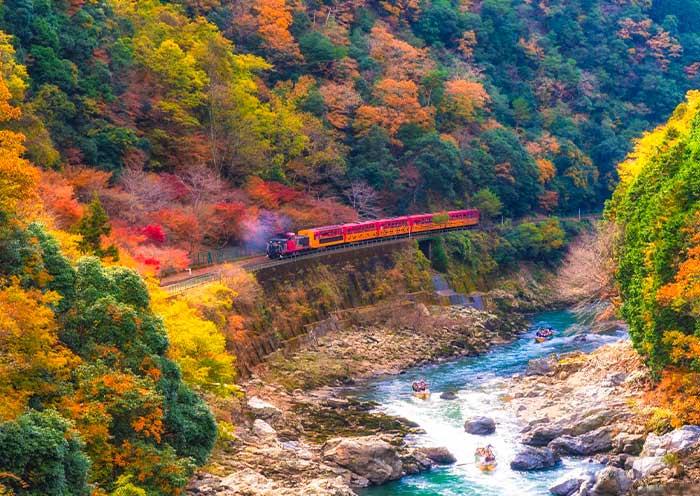

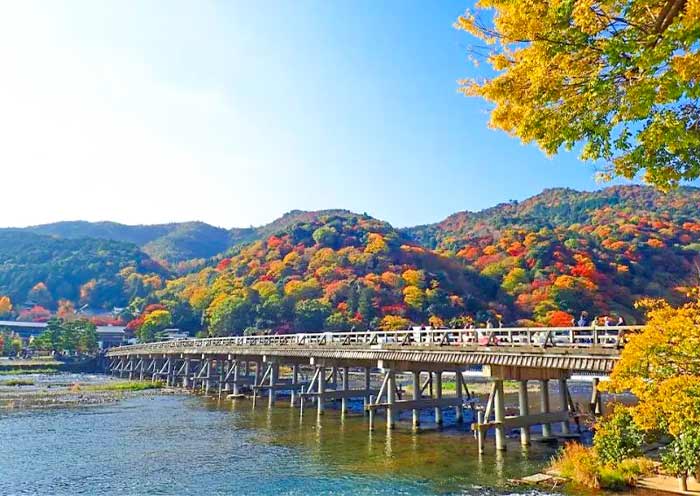
Today, you'll journey from Kyoto to Osaka, with a stop in Nara along the way.
After beakfast, depart from Kyoto and head to Nara, an approximately 1.5-hour car ride. Nara holds a special place in Japanese history as the country's first permanent capital, predating Kyoto. Nara boasts eight World Cultural Heritage sites, making it Japan's second most culturally rich city after Kyoto. In autumn, you'll witness a stunning blend of ancient landmarks, charming deer, and vibrant fall foliage in Nara, making for an exceptionally beautiful experience.
Visit Todaiji Temple, one of Japan's most historically significant temples and a UNESCO World Heritage site. It is known for housing the world’s largest bronze statue of the Buddha Vairocana, which stands just over 16m high and consists of 437 tonnes of bronze and 130kg of gold. It represents Vairocana Buddha and is flanked by two Bodhisattvas. Todaiji's main hall, Daibutsu-den (Big Buddha Hall), is one of the world’s largest all-wood buildings, despite the fact that the present reconstruction of 1692 is only two-thirds of the original temple hall's size.
Walk to Nara Park, adjacent to Kasuga Taisha. This park is famous for its hundreds of freely roaming deer, considered messengers of the gods in Shinto tradition. In autumn, the park transforms into a canvas of red, orange, and yellow hues, with maple and ginkgo trees creating a striking contrast against the ancient temple architectures and the deer that wander amongst the leaves.Purchase some shika senbei (deer crackers) to feed the deer as you stroll through the park.
Then, drive to Osaka (typically takes around 45 minutes to an hour). You will visit Osaka Castle Park, one of Japan’s most famous landmarks and a symbol of Osaka’s historical grandeur. Originally built in 1583 by Toyotomi Hideyoshi, a powerful daimyo who aimed to unify Japan, it was the largest castle of its time. After multiple renovations and reconstructions, today's Osaka Castle has been transformed into an open park, covering a total area of 105.6 hectares, making it a must-visit attraction.The park is home to numerous species of trees, including ginkgo, maple, and zelkova, which all change colors during the autumn. The historic Osaka Castle, with its distinctive green-tiled roof and white walls, provides a stunning contrast against the colorful autumn leaves, offering excellent photo opportunities.
The most breathtaking feature is the Main Tower (Tenshukaku) of Osaka Castle, which stands tall against the sky at the center of the extensive castle grounds. The castle tower's interior is a museum showcasing artifacts related to Toyotomi Hideyoshi and the castle's history. The observation deck on the 8th floor offers a panoramic view of Osaka Castle Park and the Osaka Plain. Take some time to stroll through the Nishinomaru Garden, this area has a large lawn surrounded by hundreds of cherry and ginkgo trees.
Then, head to the lively district of Dotonbori, where waterways are lined with luminous advertisements and signs. It's especially glitzy during the holiday season, with decorations strung across the bridges. Full of fantastic restaurants, clubs, and karaoke bars, it's the city's go-to area for entertainment. Take a photo at the iconic Glico Man sign. Try takoyaki, ball-shaped octopus bites, kushikatsu (Japanese deep-fried skewered meat and vegetables), and okonomiyaki, a savory Japanese pancake topped with whatever you like.
Stay overnight in Kyoto.
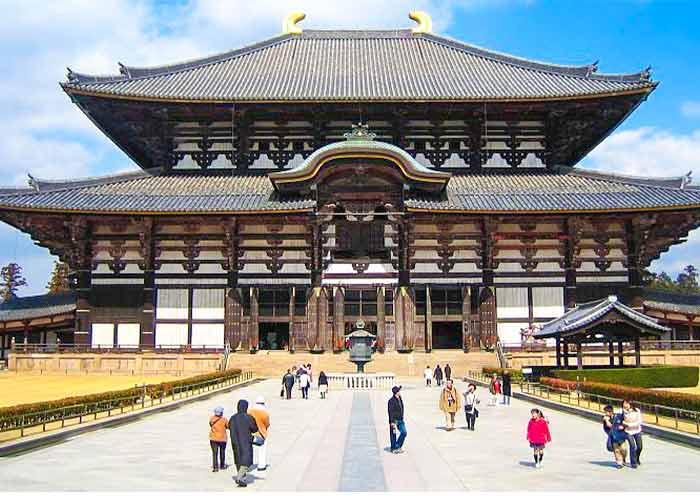
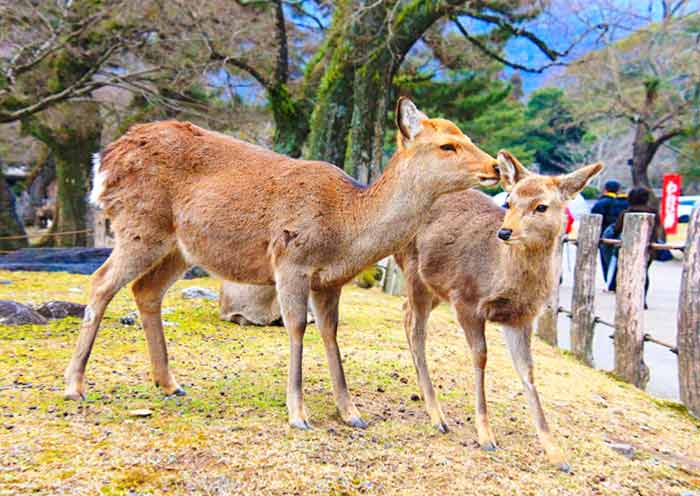


Your driver will ensure a smooth transfer to Kansai International Airport (KIX) for your departure flight.
Nihao! Welcome to Shanghai, China’s most internationalized and vibrant city! Shanghai's long-term fusion of Eastern and Western cultures has contributed to Shanghai's unique culture. Upon your arrival at the airport/train station in Shanghai, the tour guide and driver will meet and greet you at the exit, and then escort you to the well-selected hotel in downtown Shanghai. The rest of the day is free on your own so you can have a good rest for the jet lag or explore by yourself around your hotel.

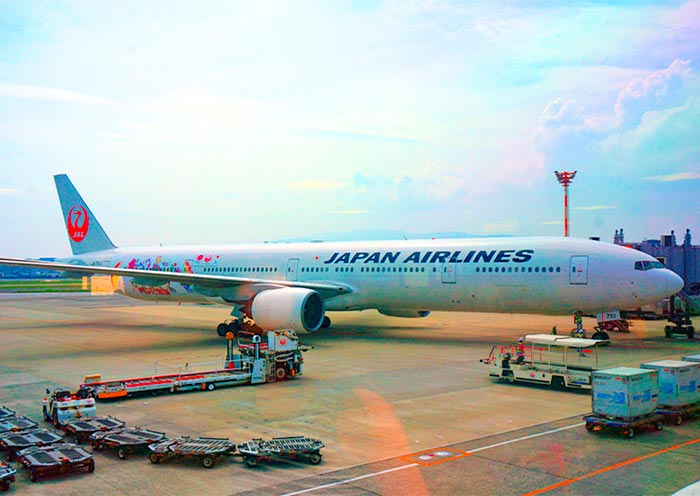

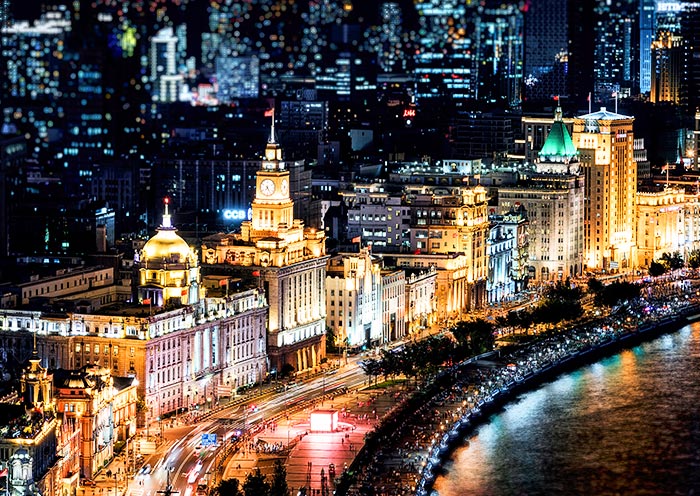
On this day, your guide will take you to Lujiazui Financial District in Shanghai Pudong New Area to the highest building in China - the Shanghai Tower. It features a dramatic 120-degree twist from its base to its peak. Take the world's fastest lifts (traveling at 64km/h) to the "Top of Shanghai Observatory" located on the 118th floor, 546 meters above ground level. Here, you'll have the unparalleled opportunity to enjoy a 360-degree panoramic view of modern Shanghai and also look down upon the Oriental Pearl TV Tower (a cultural landmark of Shanghai), Jin Mao Tower (a traditional Chinese pagoda-like structure with a modern style) and the Shanghai World Financial Center (the third tallest building in China and the fifth tallest in the world).
Next, move to Yu Garden, the most celebrated classical Chinese garden hidden in the bustling downtown area of Shanghai, where you can appreciate the beauty of a Jiangnan water town ! Yu Garden was a private garden of the Ming Dynasty (1368-1644) with a history of over 460 years, was built in 1559 by Pan Yunduan (潘允端) for his father to enjoy his retired life. You will see the winding paths and changing scenery, the plants and ponds, the brick carvings, stone carvings, clay sculptures, and wood carvings in the garden, all designed with great craftsmanship. On the way to Yu Garden, you will pass by the iconic Jiuqu Bridge (九曲桥Nine-Bend Bridge/Zigzag Causeway) and the Huxin Pavilion (湖心亭Mid-lake Pavilion, built in the Qing Dynasty, 1616-1912). According to Chinese Fengshui, the zigzag causeway is designed to thwart spirits, who can only journey in straight lines. As you enter Yu Garden, you can explore various beautifully crafted dragons hidden in the buildings, count them, and learn more about the Chinese dragon totem from your guide.
Later, explore Yuyuan Bazaar (Chenghuangmiao Market) outside Yu Garden which is a vibrant Shanghai Old Street where you can try Shanghai’s local snacks such as Xiaolongbao (Nanxiang Steamed Bun Restaurant小笼包), Pan-Fried Pork Buns (Fried Dumplings生煎包), Soup Dumplings (灌汤包), and Won-ton Soup (上海馄饨). You can also buy some traditional Chinese handicrafts and artworks for souvenirs here.
After lunch, it's time to venture into the Xintiandi near the French Concession, where you can admire the elegant residences that stand as a testament to that era. Xintiandi (新天地) is a bustling place that seamlessly blends Shikumen architecture (石库门) with modern urban fashion style. It offers a comprehensive introduction to the local Shikumen (stone-gate house) architecture, along with enticing dining and shopping options. This upscale entertainment and shopping complex is modeled on traditional “Nong Tang” (弄堂alleyway) homes and stands as the pioneering development in the city, demonstrating the commercial viability of preserving historical architecture.
Then, enjoy a leisure walk from Nanjing Road to the Bund, which is less than a 2 km walk. Nanjing Road Pedestrian Street is one of the iconic attractions of Shanghai, known as the "Number One Commercial Street in China". It serves as a window to Shanghai's openness to the world and a paradise for shoppers from both domestic and international locations. Nanjing Road is the perfect place to experience century-old Chinese time-honored shops.
At last, move to the Bund, the Top 1 Place to Visit on the Shanghai Bucket List. The Bund is the best spot to view the Oriental Pearl TV Tower (a symbol of Shanghai) and the three skyscrapers of Lujiazui that are famed as the "Kitchen Three Piece Set" (陆家嘴三件套) by locals due to their shapes: a syringe (Jin Mao Tower, 421m), bottle opener (Shanghai World Financial Center, 493m), and eggbeater (Shanghai Tower, 546m), respectively. Kown as “An Exhibition of International Buildings”, the Bund is a collection of 52 buildings representing various international architectural styles. Since 1844 (Qing Dynasty), foreign banks, trading companies, clubs, and newspapers have gathered here, showcasing the former glory of the "Wall Street of the Far East" (远东华尔街). You will visit the Zhapu Road Bridge (乍浦路桥) to capture the "Shanghai Version of Seine River Scenery"(上海版塞纳河风光), followed by Waibaidu Bridge (外白渡桥Garden Bridge of Shanghai), where you can admire the Russian Consulate building (俄罗斯领事馆green roof) that combines Baroque and German Renaissance styles. At Huangpu Park (黄埔公园), established in 1886, you can pay tribute to the Monument to the People's Heroes (人民英雄纪念塔) and discover more about the history of the Bund. After passing the Peace Hotel, you won't miss the iconic Clock Tower at the Shanghai Customs House (江海关大楼), the HSBC Building (汇丰银行), the Golden Bull Plaza (金牛广场sculpture of a golden bull), and the Gutzlaff Signal Tower (外滩天文台), all of which are classic attractions of the Bund.




This morning, your guide will meet you in the hotel lobby and escort you to Suzhou (about 1.5 - 2 hours).
Welcome to Suzhou, reputed as the "City of Gardens" and "Venice of the East," offering an elegant and picturesque atmosphere. Upon arrival in Suzhou, you will be escorted to explore this charming, poetic city.
Your first stop is a brief visit to the Suzhou Garden Museum to gain a clear understanding of the Classical Gardens of Suzhou, which consist of nine gardens in the historic city of Suzhou listed as a UNESCO World Heritage Site. Then, continue your discovery at the serene Humble Administrator’s Garden, the largest garden in Suzhou, which is considered one of the greatest examples of quintessential Chinese landscape design.
Built in 1509, Humble Administrator's Garden is the finest example of a Ming Dynasty garden. Retired magistrate Wang Xianchen created this masterpiece over 16 years. He named it to reflect his desire for a humble life after public service. The garden has three sections: the expansive Eastern Garden, the distinguished Central Garden, and the exquisite Western buildings. With its ponds, rockeries, trees, and pavilions, the garden unveils scenic views like an unrolling scroll painting. As you meander along the circular route, be impressed by the intimate courtyards, elegant architectural details, and majestic artisan stonework while immersing yourself in the gorgeous poems depicted in each architecture. These poems reflect the notable attitudes of the owners. The Orchid Snow Hall, the main hall in the eastern part of the garden, gets its name from Li Bai's poem verse "Alone between heaven and earth, the clear breeze scatters the orchid snow" (独立天地间,清风洒兰雪), implying a pure and lofty character. Walking along the path, you will come to the House of Sweet-Scented Osmanthus, the main building in the garden, named after Zhou Dunyi's essay "In Love with the Lotus" (香远益清,亭亭净植), implying noble and elegant virtues. Overlooking the fan-shaped "With Whom Shall I Sit in the Pavilion", you will evoke the atmosphere of Su Dongpo's poem "With whom shall I sit? The bright moon, the fresh breeze, and I" (与谁同坐?明月清风我). Continuing your journey, you will reach Jianshan Hall, named after the poem by Tao Yuanming "Gathering chrysanthemums by the eastern hedge, I contentedly gaze upon the southern mountains" (采菊东篱下,悠然见南山). Every step in this poetic atmosphere is accompanied by architecture that tells a story through its connection to a poem.
Important tips for appreciating and photographing Suzhou Gardens:
Begin by observing the overall layout and composition of the garden from the map. This will give you an impression of the main themes and designs.
Take a tour of the garden with an open mind to appreciate its essence. Pay attention to the use of spatial techniques like borrowed scenery, facing scenery, leaked scenery etc.
Notice the architecture - its layout, forms, and how it complements other elements like plants, rocks, water. Understand the cultural significance behind the designs.
Spend time comprehending the mood and emotions conveyed through the names of the buildings and their accompanying couplets.
Look out for scenic views that capture the seasonal beauty of the garden.
Frame and photograph interesting perspectives using the garden's structures and scenery.
After lunch, you will visit the iconic Suzhou landmark - Tiger Hill (Hu Qiu), known as the "Number One Mountain in Wu Region". This site holds cultural significance related to prominent Tang Dynasty poet Bai Juyi. He oversaw the excavation of the Shantang River, forming Shantang Street and creating the poetic transportation route of "Seven Li Shantang to Tiger Hill". “From the road leading to Kaishan Temple, water and land traffic frequently intermingled. Silver bridles guided spirited horses, while flower boats carried beautiful women” (自开山寺路,水陆往来频。银勒牵骄马,花船载丽人). At Tiger Hill, marvel at the renowned Tiger Hill Pagoda, the oldest surviving brick pagoda in China and sole remaining structure from the Five Dynasties period. Its architectural style embodies Tang and Song aesthetics. Tiger Hill Pagoda is often called the "Leaning Tower of China." Also explore the Sword Pond at Tiger Hill, said to be the entrance to the tomb of King Helü of Wu with three thousand treasure swords buried below. As described in a poem, "Bizarre rocks with a thousand monks seated, a mystical pond where a sword rests deep. The Hai Dang Pavilion on both sides, the mountain at the heart of the temple" (怪石千僧坐,灵池一剑沉。海当亭两面,山在寺中心).
Afterwards, take a leisurely stroll down Shantang Street, reputedly "Suzhou's No. 1 Ancient Street" with over 1100 years of history. As you explore, you'll discover various shops, temples, shrines, pagodas, memorial archways, guild halls, mansions, bridges, and traditional Chinese architecture. Make sure to visit the Bai Juyi Memorial Hall to see artifacts and learn about this prominent historical figure who built the street. Here, you can try local Suzhou snacks as you wander. For a unique perspective, you can opt to hop on a traditional decorated boat and cruise along the Grand Canal (about 40 minutes). This boat tour lets you experience the romance of "When you come to Suzhou, every household lives along the river", immersing yourself in the relaxed pace of life that has defined Suzhou for centuries.
After the tour, you will be escorted to your hotel in Shanghai.



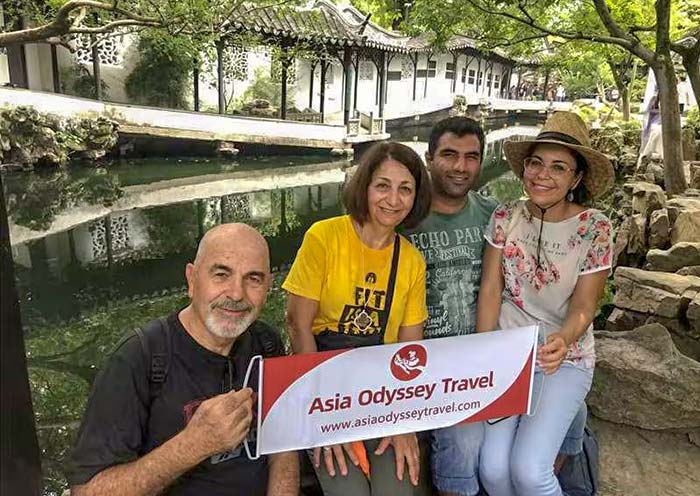
Today, you will head to the airport for your flight to Xian (about 2.5 hours). Welcome to Xian, the capital of 13 ancient China dynasties! Upon your arrival in Xian, the local guide and driver will greet you at the exit of the airport, and then escort you to your hotel in Xian downtown area. Enjoy some free time on your own after the hotel check-in.


After breakfast, drive about 40 km to the Terracotta Warriors Museum (Museum of Qin Terra-cotta Warriors and Horses). Here, you can discover the Terracotta Warriors and Horses: an army of around 8,000 soldiers, 130 chariots, 520 horses, and 150 cavalry entirely made of baked clay or terracotta. This Terracotta Army has silently stood guard over the soul of China's first emperor, Qin Shihuang, for more than 2,000 years. Until an accidental local farmer digging a well in 1974 struck upon one of the greatest archaeological discoveries in the world. Upon stepping into this "underground military museum," you will encounter two awe-inspiring shocks. The first is the magnitude of the archaeological marvel before you: thousands of life-sized clay soldiers, horses, and chariots arranged in battle formations. The second shock is that the faces of thousands of Terracotta Warriors are still vivid, despite the passage of more than 2,000 years. Each figure is unique, with distinct postures, hairstyles, and armor, making them seem to come back to life in the next moment.
During your visit, an knowledgeable guide can take you to highlights of the museum, including Pit One, Pit Two, Pit Three and provide valued explanations and insights that you might not get from simply observing the sculptures on your own. Afterward, you will have a rare opportunity to create your own miniature Terracotta Warrior under the guidance of a local potter. This will allow you to appreciate the craftsmanship and techniques of the Qin Dynasty as well as gain a deeper understanding of how terracotta warriors were made.
After lunch, drive back downtown to visit the Giant Wild Goose Pagoda which is one of Xi'an's most recognizable landmarks and a symbol of the magnificence of the Tang Dynasty. This seven-story pagoda, standing in the tranquil Da Ci'en Temple, is one of China's best examples of a Tang-style pagoda (squarish rather than round). It was completed in AD 652 to house Buddhist sutras brought back from India by the monk Xuan Zang. His travels inspired one of the best-known works of Chinese literature, Journey to the West. While at the Giant Wild Goose Pagoda, you'll also have the opportunity to immerse yourself in the local culture by trying on Hanfu (traditional Chinese clothing), and capture memorable moments in Hanfu.
As evening falls, visit the Grand Tang Dynasty Ever Bright City which showcases the life and times of the Tang Dynasty. The light show is decorated with structures, creating a vibrant and immersive atmosphere that transports you back to the times of the Tang Dynasty, providing a magical experience of walking through time.
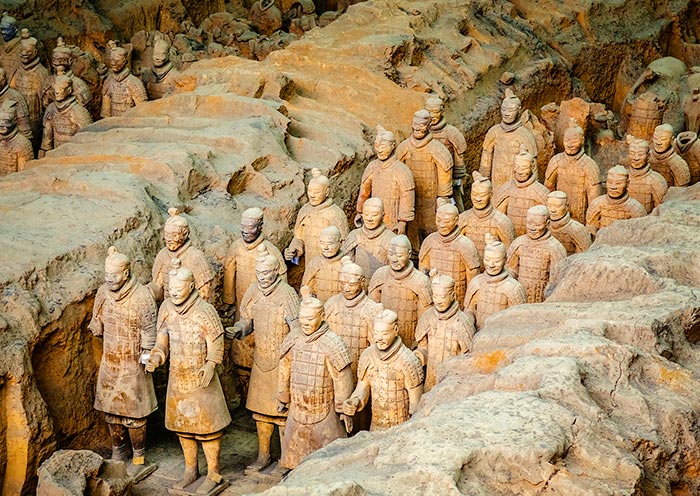
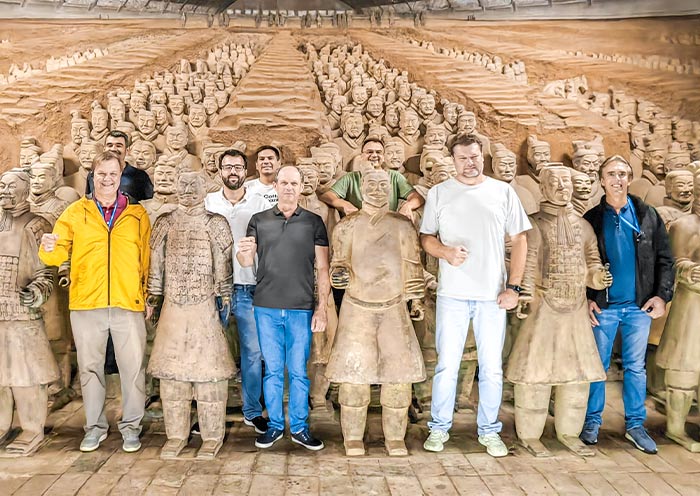

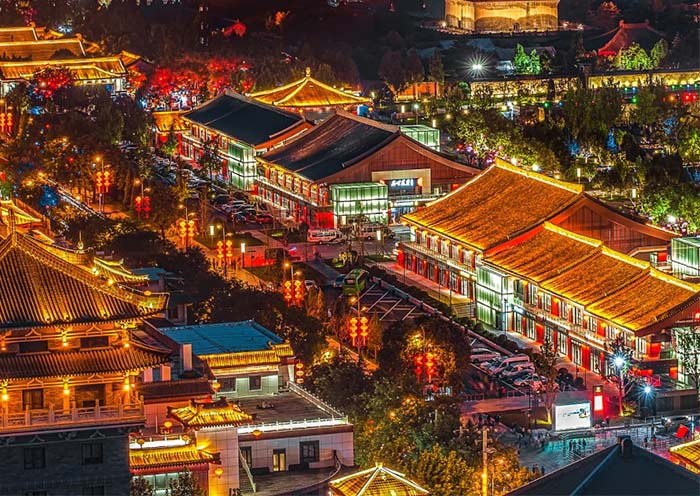
This morning, your guide will meet you in the hotel lobby and escort you to visit the Ancient City Wall. Xi'an is one of the few cities in China where the imposing old city walls still stand. Built in 1370 during the Ming dynasty, the magnificent 12-meter-high walls, form a rectangle with a perimeter of 14 kilometers. To get an idea of Xi'an's former grandeur, take a leisurely walk on the wall. Each step here is a chance to resonate with the echoes of history that the stones reverberate. Or cycling ( optional ) the full extent of the wall offers a rewarding panoramic view of the city - a tangible contrast between the old and new, and a testament to Xi'an's historical significance and modern vibrancy. Once you've delved into the city's historical narrative, don't forget to indulge in the delicious food and experience the vivid local life.
Optional activities:
Rent a bike cycling on the Ancient City Wall;
The Muslim Quarter is a paradise mixed with different local snacks and Muslim culture, and you can surely taste the most authentic local food there. Don't miss the Great Mosque, an architectural gem that beautifully blends Islamic and Chinese design styles. After the tour, you will be escorted to a well-selected hotel in downtown Xi'an. The rest of the day is free for you to either rest and recover from jet lag or explore the area around your hotel on your own.
After the tour, you will be transferred to the train station for your high speed train to next destination - Beijing. Upon arrival in Beijing, your guide will meet you at the train station and escort you to your hotel. The rest of the day is free on your own so you can explore by yourself around your hotel.
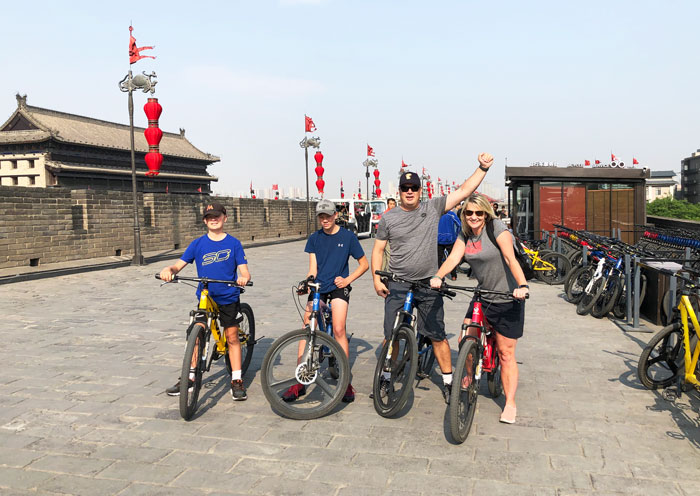



Today you will spend the whole day exploring the ancient citadel Beijing through China’s famous landmarks, epic imperial grandeur and royal gardens.
After breakfast, your guide will pick you up at your hotel and then head to Tian’anmen Square, which is the world’s largest public square and also the symbol of China. It has witnessed many big events in China over the past decades and from here you can take good pictures of Tiananmen Gate showing on CCTV News every day.
Walk across the square and you will visit the might and splendor of the awe-inspiring Forbidden City, the world’s largest palace complex and one-time home to 24 emperors of China. Listed as a world heritage site, Forbidden City has about 500 years’ history, and served as the political and ritual center of China during the Ming (1368-1644) and the Qing (1644-1911) dynasties. With over 8,728 rooms, the Forbidden City is not only China’s largest and best-preserved collection of ancient buildings, but also a city within the city, like the Vatican in Rome. Enter through Meridian Gate and visit along the central axis to ensure you won’t miss any highlighted palaces. You can admire its brilliant architecture and numerous ancient art treasures while listening to your guide and learning more about the emperors’ stories hidden inside the Imperial Palace. Later, take another 15-minute walk up to Jingshan Park, where you can have a magnificent panorama of modern Beijing and princely views over the russet roofs of the Forbidden City.
In this afternoon, drive to the “Museum of Royal Garden” - Summer Palace, which used to be the resort for royal families to flee summer heat. The grounds, temples, gardens, pavilions, lakes, bridges, gate-towers, and corridors are a marvel of landscaping. Enjoy the leisure walk and take your time to appreciate the imperial architectures, hilltop views, and beautiful lakes, which offer a pastoral escape into the landscapes of traditional Chinese painting.
Recommended Optional Activity: You can try the famous Peking Roasted Duck at Quanjude this evening.

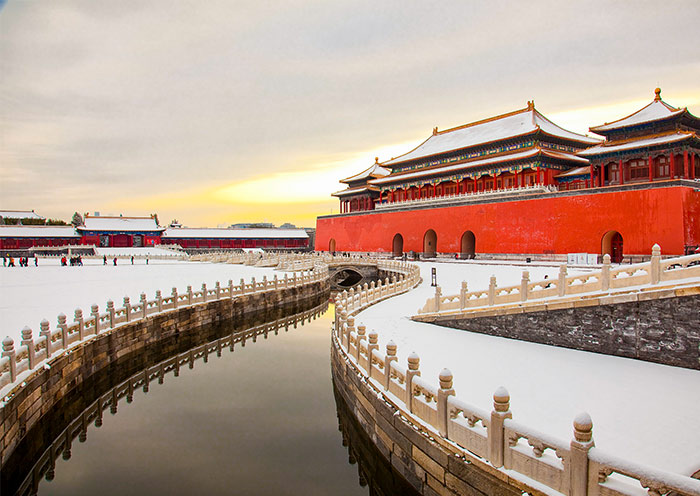
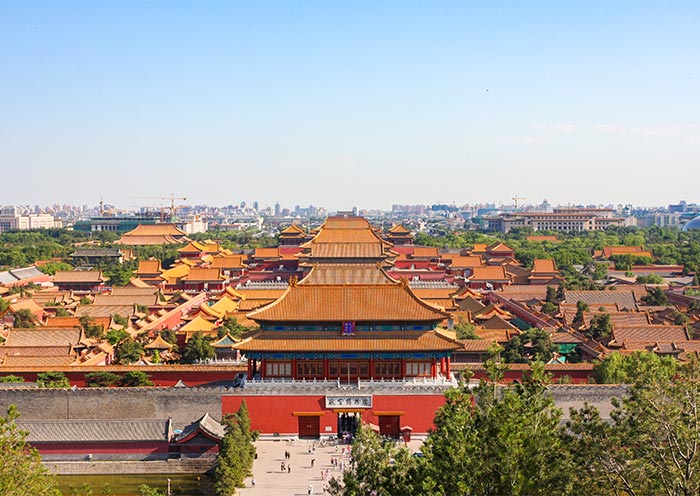

In this morning, you will head northwest of Beijing (about 1.5-2 hours’ drive, 73km) to the Great Wall at Mutianyu. The Great Wall boasts a history over 2,000 years and stretches more than 3,000 miles across several provinces of northern China, making it one of the most impressive ancient masterpieces on the planet. Mutianyu Great Wall is connected with the Jiankou Great Wall in the west and the Gubeikou Great Wall in the east. Mutianyu is the longest and best fully-restored Great Wall with fewer tourists and is also famed for its 23 Ming-era watchtowers and stunning views. Take the cable car up to the 14th watchtower and then enjoy the memorable hiking time on the wall while visiting its western route. With the green pines and cypresses covering the surrounding area, and the winding wall standing majestically on the vast land, you will capture the most stunning natural scenery in this section. Challenge yourselves while climbing up to the 20th watchtower where you could fulfill your Great Wall dream. Cherish the chance and take photos as many as you like!
After the once-in-lifetime experience, head back to downtown Beijing and have the chance to take photos with the exterior of the Bird's Nest (Beijing National Stadium) and Water Cube (Beijing National Aquatics Center). They were both designed for the 2008 Beijing Olympics and used for the 2022 Winter Olympic Games. After that, transfer back to your hotel and have a good rest tonight.

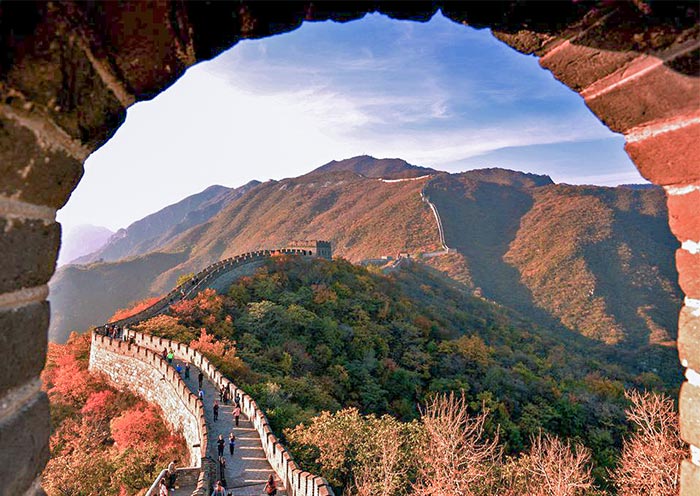
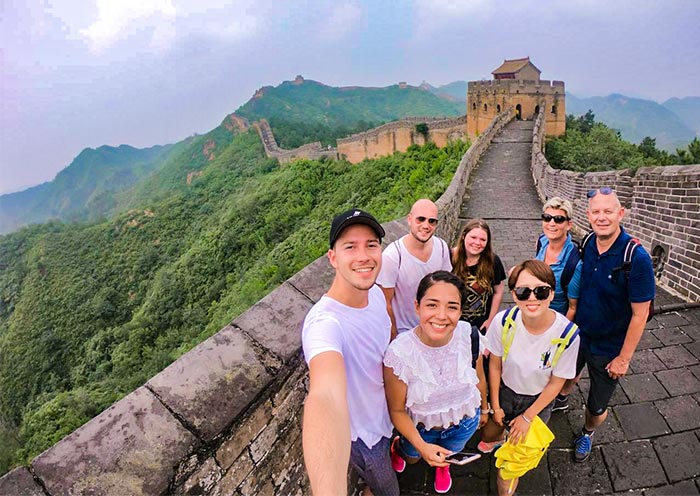

This morning you will head to Temple of Heaven. Located in Beijing's Tiantan Park, the Temple of Heaven is much bigger than the Forbidden City and smaller than the Summer Palace. As a World Heritage, the Temple of Heaven (Taoist temple) is also known for its rigorous symbolic layout, peculiar structure, and magnificent decoration. The Temple of Heaven used to be a place to offer sacrifice to Heaven by 22 Chinese emperors twice a year for good harvests. You can learn more about the grand praying ceremony there, as well as observe the amazing designs such as the Echo Wall and the Triple Sound Stones. Nowadays, it is also a park for local people to do morning exercise and you are welcome to join them.
If there is more time, you can also enjoy the relaxing time exploring the ordinary local life through the old Hutongs. Take a rickshaw tour to travel through the narrow alleys with many featured shops standing on both sides.
Then, it is time to end your 12 Days Japan China Tour. Your guide will escort you to the airport/train station for your flight or high speed train to your next destination.
Thank you for choosing Asia Odyssey Travel for your China tour, and we are always here working for you and hope to see you again for your next trip to China/Asia.




Price: What’s Included & What’s Excluded
What's Included:
What's Excluded:
Important Travel Tips for Visiting Japan
Get the right visa. Depending on your nationality and the length of your stay, you may need to apply for a visa in advance. You can do this online or at a Japanese embassy or consulate. Many countries are part of Japan’s visa exemption program, allowing their citizens to enter Japan for short stays without a visa for tourism. Always check if your country is on this list before applying for a visa. If you have any questions, feel free to contact our travel experts for more information.
The best time to visit Japan depends on your interests:
Spring (March to May): Ideal
for witnessing the cherry blossoms and enjoying mild weather. Major cities like Tokyo, Kyoto, and Hiroshima
are particularly beautiful as cherry trees bloom spectacularly.
Summer (June to
August): Perfect for experiencing vibrant festivals such as Gion Matsuri in Kyoto,
Tanabata Matsuri across the country, and enjoying the natural beauty of Hokkaido, which is less humid than
the rest of Japan. Note that early summer (June) is the rainy season.
Autumn (September to
November): Offers stunning fall foliage, making it a great time for hiking and temple
visits. The weather is cool and pleasant, ideal for outdoor activities.
Winter (December to
February): The best time for winter sports, especially in regions like Hokkaido and the
Japanese Alps. Onsens (hot springs) are also a popular attraction during the cold months.
Bring Cash. Despite advances in digital payment, many smaller vendors, temples, and rural
areas operate predominantly with cash. It’s wise to keep some yen on hand at all
times.
Universal Travel Adapter. Japan uses 100V with two straight thin
pins.
Passport: Ensure it’s valid for at least six months beyond your date
of travel.
Visa (if required): Make sure you have the right visa for your
travel.
Travel Insurance Information: Always good to have on hand.
Bow when greeting: A slight bow is a common way to say hello, thank you, or
sorry.
Be mindful of your noise level: Japanese culture values quietness,
especially in public transportation and residential areas.
Follow the rules: Whether
it's waiting in line or adhering to signage, following local rules and etiquette is highly
valued.
Etiquette in temples and shrines: Wear modest clothing and follow specific
customs such as washing hands and mouth before entering a shrine or temple. Photography might be restricted
in sacred areas.
Looking for more travel guides for first-time visitors to Japan? Want to gather additional information to plan your trip? Our team of professional travel experts has written over 40 articles about Vietnam. Please check out ourJapan Travel Guide for inspiration and detailed insights.
Hotel Conditions for Your Japan Tour
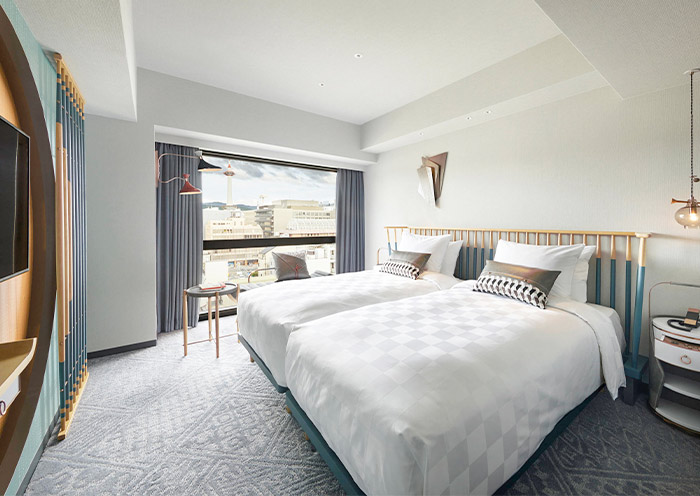

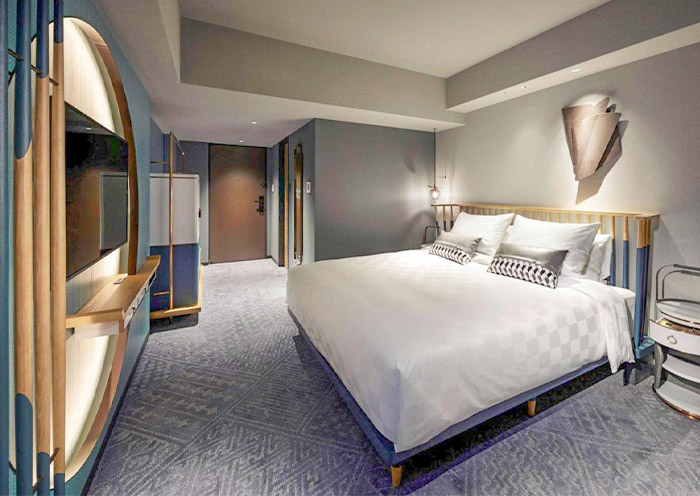

We offer a range of accommodation options to suit various preferences and budgets: luxurious 5-star hotels, comfortable 4-star hotels, and economical 3-star hotels. Our selected hotels are conveniently located close to the city center or popular tourist spots.
For those seeking a more distinctive lodging experience, we also offer Traditional Ryokans, Machiya, Onsen (hot springs) Hotels, etc. If you have specific needs or preferences, please consult with your travel advisor.
Tips: Be aware that hotel room sizes in Japan may be smaller compared to those in other developed countries due to the scarcity of land. If your budget allows, it is recommended to opt for a higher category of hotel, which will generally offer more comfort.
Photo Gallery for This Itinerary
Latest Japan Tours Reviews from Our Customers

Sam Lin
Singapore
Date of Experience: Dec 24, 2024
Tour Customized by: Vincent
You May be Interested in This Tour: 8 Days Best Japan Group Tour: Japan Highlights & Hiroshima

Zhang Xin Hua
Malaysia
Visiting Japan’s Golden Route in October was incredible! From Tokyo's vibrant city life to the serene beauty of Mount Fuji, every stop was unforgettable. Kyoto’s temples and Nara’s friendly deer captured Japan’s charm, while Osaka’s food scene was a delight. The mix of tradition and modernity made it a perfect 7-day journey!
Date of Experience: Oct 26, 2024
Tour Customized by: Allan
You May be Interested in This Tour: 7 Days Japan Golden Route Tour in Small Group

Dan Z
Washington DC
Date of Experience: Aug 24, 2024
Tour Customized by: Rex
You May be Interested in This Tour: 7 Days Japan Kansai Tour with Hiroshima: Osaka, Kyoto, Uji & Nara
Price: request
(Based on a private tour for two people. Price varies depending on program, travel date, number of people.)
Free Enquiry! You don’t need to pay for the reservation.
- United States (+1)
- Australia (+61)
- Singapore (+65)
- Malaysia (+60)
- Philippines (+63)
- Canada (+1)
- Italy (+39)
- Indonesia (+62)
- United Kingdom (+44)
- Spain (+34)
- Mexico (+52)
- Hong Kong (+852)
- Thailand (+66)
- United Arab Emirates (+971)
- New Zealand (+64)
- South Africa (+27)
- Germany (+49)
- Brazil (+55)
- India (+91)
- France (+33)
- Vietnam (+84)
- The Netherlands (+31)
- Saudi Arabia (+966)
- Ireland (+353)
- Argentina (+54)
- Switzerland (+41)
- Romania (+40)
- Pakistan (+92)
- Japan (+81)
- Portugal (+351)
- Bangladesh (+880)
- South Korea (+82)
- Puerto Rico (+1)
- Türkiye (+90)
- China (+86)
- Belgium (+32)
- Qatar (+974)
- Greece (+30)
- Taiwan (+886)
- Austria (+43)
- Poland (+48)
- Israel (+972)
- Chile (+56)
- Sri Lanka (+94)
- Nigeria (+234)
- Peru (+51)
- Colombia (+57)
- Hungary (+36)
- Nepal (+977)
- Denmark (+45)
- Bulgaria (+359)
- Norway (+47)
- Slovenia (+383)
- Sweden (+46)
- Kuwait (+965)
- Costa Rica (+506)
- Ecuador (+593)
- Venezuela (+58)
- Malta (+356)
- Croatia (+385)
- Tunisia (+216)
- Czechia (+420)
- Mongolia (+976)
- Bahrain (+973)
- Mauritius (+230)
- Papua New Guinea (+675)
- Cambodia (+855)
- Dominican Republic (+1)
- Luxembourg (+352)
- Finland (+358)
- Guatemala (+502)
- Myanmar (+95)
- Maldives (+960)
- Slovakia (+421)
- Laos (+856)
- Serbia (+381)
- Brunei (+673)
- Oman (+968)
- Macao (+853)
- Panama (+507)
- Morocco (+212)
- Jordan (+962)
- Georgia (+995)
- Fiji (+679)
- Bolivia (+591)
- Lithuania (+370)
- Bahamas (+1)
- Cyprus (+357)
- Latvia (+371)
- Bhutan (+975)
- Iraq (+964)
- Iran (+98)
- Kenya (+254)
- Jamaica (+1)
- Zimbabwe (+263)
- Azerbaijan (+994)
- Uruguay (+598)
- Estonia (+372)
- Andorra (+376)
- Cameroon (+237)
- Ghana (+233)
- Kazakhstan (+7)
- Nicaragua (+505)
- Egypt (+20)
- Russia (+7)
- Albania (+355)
- Réunion (+262)
- Montenegro (+382)
- Algeria (+213)
- Afghanistan (+93)
- Martinique (+596)
- Uganda (+256)
- Honduras (+504)
- North Macedonia (+389)
- Trinidad and Tobago (+1)
- Suriname (+597)
- Antigua and Barbuda (+1)
- Zambia (+260)
- Ukraine (+380)
- Armenia (+374)
- Barbados (+1)
- Belarus (+375)
- Palestine (+970)
- Lesotho (+266)
- Moldova (+373)
- Ethiopia (+251)
- French Polynesia (+689)
- Gambia (+220)
- Guam (+1)
- Gibraltar (+350)
- Isle of Man (+44)
- New Caledonia (+687)
- El Salvador (+503)
- Comoros (+269)
- Seychelles (+248)
- Chad (+235)
- Samoa (+685)
- Cook Islands (+682)
- Palau (+680)
- Paraguay (+595)
- DR Congo (+243)
- Solomon Islands (+677)
